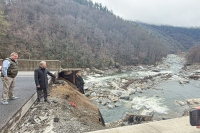Swain County to sue federal government over North Shore Road settlement money
 After waiting for years to get the money promised to them, the Swain County commissioners made a unanimous decision last week to sue the federal government for $38.2 million.
After waiting for years to get the money promised to them, the Swain County commissioners made a unanimous decision last week to sue the federal government for $38.2 million.
“It’s about our only option left,” said Commissioner Steve Moon.
The $38.2 million is what the federal government still owes Swain County for flooding and destroying a road in the 1940s when it constructed Fontana Dam.
Originally, the federal government promised to rebuild the 30-mile road that connected Bryson City to Tennessee, but it never happened. In 2007, the National Park Service agreed to a cash settlement of $52 million that had already been approved by Swain County Commissioners. With the settlement agreement running out in 2020, the county is feeling the crunch to get its hands on the money before it disappears for good.
“The federal government has actually lied to us for so many years — it’s been 70 years since the original promise was made — yet very little has ever been done,” Moon said. “They’ve made it seem like it’s perfectly fine to lie to the citizens, so we need to try to hold them accountable.”
After fighting tooth and nail for years to get the road rebuilt, the county finally agreed to take a cash settlement instead. That should have been the end of it, but the federal government has paid out only $12.8 million of the settlement.
Related Items
Commissioner Chairman Phillip Carson announced the decision to file a lawsuit last Thursday after commissioners returned from an hour-and-a-half-long closed session with County Attorney Kim Carpenter.
While there was no official vote taken, Carson said commissioners unanimously agreed to direct Carpenter to act on behalf of the board of commissioners.
Carpenter said Attorney Douglas P. Wheeler and the law firm of Hogan Lovells in Washington, D.C., would file the lawsuit against the U.S. Department of Interior on behalf of Swain County related to the settlement agreement.
“The Board of Commissioners directed the Hogan Lovells firm to file the action in the Court of Federal Claims, which is the venue for claims against the United States. Once filed, the U.S. Department of Interior will have 30 days to file a responsive pleading,” she said.
Wheeler, who is a partner at Hogan Lovells, is an environmental lawyer who focuses on federal regulatory issues and matters pertaining to land use and growth management. Wheeler also served as the Secretary of Resources for California from 1991-99 and served as the assistant legislative counsel for the U.S. Department of Interior for seven years.
Commissioners David Monteith and Carson recently returned from a trip to Washington, D.C., where they met with U.S. Rep. Mark Meadows, R-Cashiers, and U.S. Sen. Richard Burr, R-N.C., and discussed the ongoing issue of the settlement money.
“At the meetings we discussed the North Shore settlement money owed to Swain County by the federal government,” Monteith said. “We also met with the Interior Department and National Park Service attorneys concerning the settlement money.”
The visits to the capital have become an annual occurrence, but it hasn’t helped them get the money. Rep. Meadows said he fully supported the decision of the commissioners in their quest to get what is owed to their residents.
“They have represented the people who have elected them in a wonderful fashion,” he said. “We’ve had no less than two dozen meetings as it relates to the funding, so this decision to potentially file a lawsuit is not something that comes as a surprise to me.”
Broken promises
Suing the federal government is obviously a last resort for the county, but commissioners are at the end of their ropes. Current and previous county leaders — as well as their representatives in Washington — have been fighting for years with little result.
It’s an issue with a lot of history and hurt feelings. Many Swain County residents still remember their parents or grandparents being forced off their land so the Great Smoky Mountains National Park could be created. The creation of Lake Fontana flooded numerous communities and forced families to move.
However well intentioned, those actions have left Swain County families with a deep distrust of the federal government. The government’s empty promise of rebuilding the road has only added to residents’ skepticism.
Before the settlement was reached in 2010, commissioners and the community were torn on whether taking a settlement was the best option given the federal government’s habit of not following through. Some saw a settlement agreement as nothing more than another meaningless piece of paper and were dead set on getting the money to rebuild the road. Monteith was part of that camp.
“We might get the $6 million, the rest of it is a promise that we might do this in the 2009 budget. What good is a promise? We’ve been waiting 60 years. They are asking us to trust them again? I have no confidence,” Monteith said back in 2007 when the settlement was still being debated.
Monteith’s prediction was dead on. Under the agreement, the federal government was supposed to make an initial payment of $12.8 million the same year the settlement was reached and was then obligated to make annual payments until the $52 million was paid off. The initial payment was made, but the county hasn’t received a dime since then.
Some county leaders and residents came to terms with the slim likelihood the federal government was going to spend $600 million on rebuilding the road and instead fought hard for a cash settlement.
The Citizens for the Economic Future of Swain County, a group that first proposed the idea of a monetary settlement, came up with the $52 million figure, which was based on the value of the road at the time it was flooded plus interest and inflation.
What went wrong?
Three U.S. representatives from North Carolina have taken up the fight in Washington for Swain County. Rep. Charles Taylor was adamantly against the settlement and wanted the government to honor its original agreement to replace the road. Rep. Heath Shuler, a Swain County native, fought for the settlement when he was elected, and now Rep. Meadows is fighting to get Swain County the rest of the settlement money.
While the language and the intent of the settlement agreement seems crystal clear to Meadows, he said the issue has gotten caught up in an “earmark ban” in Washington. Even though this is more of a contractual agreement, everyone in politics knows earmarked projects have “pet project” written all over them and they don’t have a chance of getting through.
“This is the real definition of bureaucratic red tape,” Meadows said about the situation. “This is why most decisions need to be made at a local level. Bureaucrats get to hide behind their desks and wonder why something so simple can’t be done.”
Even when the $4 million installment for Swain County was included in the National Park Service’s budget in 2012, the department claimed it didn’t have the authority to release the funds and asked for additional authorization from Congress.
During his tenure, Shuler even asked the General Accounting Office for an opinion on whether the Park Service could turn over the money in its budget without a specific vote by Congress saying it was OK. The General Accounting Office said that the Park Service could release the funds to Swain County if it wanted to.
It’s become the classic run-around. The National Park Service didn’t ask for additional authorization on any other items outlined in its budget. The funding sat there so long that Congress rescinded the allocation because it was unspent. The settlement installment hasn’t even made it into the budget during the last two fiscal years.
Meadows said he has made the North Shore Road settlement a top priority since taking office in 2012. He said he’s worked with legislators on both sides of the aisle to get the issue resolved. He’s made countless personal calls to Department of Interior personnel but continues to have an uphill battle with an administration that refuses to appropriate the money in the National Parks Service budget.
“This is the last thing Rep. Shuler worked on before leaving office and it’s the first thing I worked on when I came into office, so it’s not a lack of follow-up from anyone,” Meadows said.
He’s been working with Sen. Thom Tillis, R-N.C., to present legislation that would address the problems in the appropriation process, and he should have a better idea in a few more months whether that approach will be successful in getting the money released. While he’s hopeful and will continue to keep trying, Meadows said he doesn’t want to be naïve about the situation either.
“The next few months will tell us whether we can get it done through the appropriations process, but I certainly encourage commissioners to go down this path on parallel tracks to make sure they get what’s owed to them,” Meadows said. “My favorite line is ‘If you can’t make them see the light, make them feel the heat.’”
Community reaction
Swain County residents seem supportive of the county commissioners’ actions to sue the federal government, but not all of them are convinced it will do any good. Leonard Winchester, chairman of the Citizens for the Economic Future of Swain County group, said he couldn’t claim to be a lawyer or predict how the case would be laid out. But if he were a betting man, he’d bet Swain County never sees that money.
“I think the remaining money will not reach appropriations based on statements made by the director of the National Park Service. He indicated it was a matter for the Department of Interior,” Winchester said. “And the new (Department of Interior) secretary, when they questioned her about it, she handed it off to someone else saying it was a conflict of interest for her and that’s hard for me to comprehend. I took that as a clue (Secretary) Sally Jewell had no intention of seeking appropriations.”
Even if the money did somehow get appropriated, Winchester said it would be labeled as an “earmarked” project and would raise a red flag for other congressmen. However, when asked if it was worth the money to fight it, Winchester didn’t hesitate.
“Yes, it’s worth the fight. I have even said so to the county manager and commissioners,” he said. “We had ideas for how the interest from the money should be used — for special projects the county hasn’t had money for — and I would definitely consider this one of those special projects.”
Right now the $12.8 million is sitting in a trust fund managed by the N.C. Treasury Department collecting interest. County Manager Kevin King said the county would be using some of that interest money to pay for the upcoming legal fees.
Rick Bryson, a Swain County native who is running to unseat Meadows in the 11th Congressional District, said he has encouraged the commissioners for a couple of years to file a lawsuit against the federal government for the settlement money. He isn’t convinced it will work, but he thinks it will get their attention and put pressure on the Department of Interior to do something.
“I’ve said for a while we ought to stop playing patty-cake with these guys in Washington and sue them,” he said. “We have a 2020 deadline to get that money.”
North Shore Road timeline
• 1920s — Forney Creek Township wants a road leading from Bryson City to Deals Gap on the Tennessee state line. It is the height of the timber boom and the road would improve access to Knoxville. The community took out bonds totaling $400,000 to pay for the road.
• 1934 — The Great Smoky Mountains National Park is officially created.
• 1940 — Forney Creek Township has yet to pay a single cent on the road bonds it took out nearly 20 years prior. With interest, the amount now comes to $694,000. The county assumes the outstanding debt. It refinances the bond for $1.3 million, which also includes money for a new school.
• 1941 — President Roosevelt authorizes federal funding to build Fontana Dam on the Little Tennessee River. Tennessee Valley Authority begins land acquisition.
• 1943 — 44,000 acres is added to the Great Smoky Mountains National Park and the people evacuated, along with those in the direct path of rising water. An agreement is signed between Swain County commissioners, the governor of North Carolina, Tennessee Valley Authority and the Department of Interior that promises to build a new road — provided Congress appropriates the funds — along the north shore of the lake.
• 1947-48 — National Park Service builds 0.9 miles of the promised road on the Fontana Dam side.
• 1959 — State of North Carolina constructs a road from Bryson City to the national park boundary, laying the groundwork for the park to pick up construction.
• 1960 — Congressman Roy A. Taylor secures $8 million for construction of the North Shore Road. Park Service commences road construction where the state left off.
• 1962 — National Park Service issues a report stating “it appears to be in the public interest to seriously reconsider the plan” to build the road.
• 1968 — Construction on the road stops after 7 miles. The Park Service has used up the $8 million and is out of money. The prospects for more money seem slim due to environmental opposition.
• 1974 — Contingency from Swain County makes a trip to Raleigh to visit N.C. Attorney General Robert Morgan. They ask Morgan for the state’s help suing the federal government to resolve the 1943 agreement. They learn they have no grounds for a lawsuit, due to a hold harmless clause in the agreement.
• 2003 — Citizens for the Economic Future of Swain County hire an accounting firm to come up with a figure for the monetary settlement. They arrive at $52 million, based on the cost of the road when it was flooded, with interest and adjusted for inflation. Commissioners vote 4-1 in favor of the settlement.
• 2007 — National Park Service announces its long-awaited decision in the lengthy environmental assessment. It comes down in favor of a cash settlement.
• 2010 — Swain County receives the first installment of $12.8 million.
• 2011 — A $4 million payment is appropriated in the National Park Service budget but then rescinded mid-year after being caught up in an across-the-board clampdown on earmarks by Congress.
• 2012 — A payment is again appropriated, but the National Park Service refuses to release it, claiming it lacks clear authority to do so.
• 2013 — The payment never makes it in the federal budget.
• 2014 — The payment never makes it in the federal budget.













